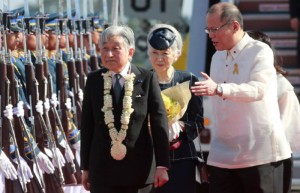Special to WorldTribune.com
 By Donald Kirk, EastAsiaIntel.com
By Donald Kirk, EastAsiaIntel.com
MANILA ― No city suffered more in World War II than this sprawling metropolis of more than 10 million people.
No enemy was more cruel, more hostile, more destructive than the Japanese after defeating U.S. forces in the Philippines at the outset of the war in the Pacific. Japanese commanders knew the Americans were returning and would soon regain control yet did nothing to halt the atrocities that resulted in the deaths of more than a million Filipinos.
Under these circumstances, it seems almost beyond belief that the Japanese Emperor Akihito and his wife, Empress Michiko, could return to the Philippines as deeply honored guests, paying homage to Japanese war dead while bowing low in remorse for the suffering the Japanese had caused during three years of harsh rule. Elderly Filipinos still talk of the harshness of the Japanese even in regions far removed from combat.

Akihito and Michiko visited the Philippines last week on a peace offensive in which they created nothing but a great impression even as aging comfort women recalled their fates as sex slaves for Japanese soldiers. On a journey fraught with symbolism, the imperial couple, powerless in their own country, had no power to do anything in response to demands and protests. Their mission was totally without substance.
Their mere presence, however, fortified the impression of increasingly close relations between the Philippines and Japan while both countries worry about the rising power of China. The two share common cause against Chinese claims to almost the entire South China Sea while Japan also defies Chinese claims to the Senkaku Islands, a.k.a. Diaoyu to the Chinese, in the East China Sea.
The unalloyed warmth of the reception given Emperor Hirohito and Empress Michiko by the Philippines President Benigno Aquino III gives rise to the obvious question about how they might conceivably be received in South Korea. The question is largely hypothetical given that relations between Japan and Korea are too complex, too bitter, too unsettled for a visit of this sort to be at all likely, but comparisons between the Korean and Philippine experience at the hands of the Japanese are still valid.
Korea and the Philippines, so different as societies, share common memories of subjugation by the Japanese even if their responses are quite different. One reason no doubt is that the Japanese controlled Korea for 40 years beginning in 1905, five years before “annexing” Korea in 1910, whereas their reign over the Philippines was relatively brief. Another is that tens of thousands of comfort women were rounded up in Korea whereas only a thousand or so Philippine women were forced into sexual slavery.
Yet the Philippines and Korea have a history of ambivalence toward Japan that’s quite striking. Many Filipinos served the Japanese willingly ― among them the grandfather of President Aquino ― while many more aided the Americans, cheering their return. Similarly, many Koreans served the Japanese during the colonial era while others resisted. The movement of March 1, 1919, endures as a reminder of the fierce desire among Koreans for independence from colonial repression.
As tensions rise with China, Japan would obviously like to make up for past wrongs with a number of countries. It was with that hope in mind that Japan and Korea reached agreement in December on the comfort woman issue ― Japan promising to set up a fund of approximately $8.3 million by way of compensation. Whether that agreement ever works, however, is problematic while the Japanese object to the statue of the comfort woman across a narrow street from their embassy in Seoul.
The success of the visit of Akihito and Michiko to the Philippines, though, might serve as a precedent. Filipinos may never forget the ravages perpetrated upon Manila in the Pacific War, but time heals all wounds. Japan is the Philippines’ largest trading partner, and the Philippines welcomes Japanese economic assistance in road-and-bridge building and other infrastructural projects. On a much smaller scale, Japan is extending military aid and cooperation as well.
Korea’s needs, of course, are far different from those of the Philippines. Militarily, South Korea is vastly more powerful than the Philippines, whose ragtag armed forces are ineffective against Communist and Muslim revolt, much less against the Chinese on the Spratly Islands. Still, as North Korea raises the threat level in Northeast Asia and the Chinese fail to do anything about it, Japan and South Korea are also showing signs of military cooperation.
Memories of the colonial period are too deeply ingrained in the Korean psyche to imagine Korea and Japan would become military allies. They both count on separate alliances with the U.S. to guarantee security. So, for that matter, does the Philippines.
In the final analysis, though, the visit of the Japanese imperial couple was a little deceptive. They created no controversy, provoked almost no protest. Without hinting at anything overtly, they managed to win hearts and minds. Whether they ever come to Korea, that type of salesmanship may be what’s needed to overcome the legacy of past misdeeds.
Donald Kirk has been covering war and peace in Asia for decades. He’s at kirkdon4343@gmail.com.
